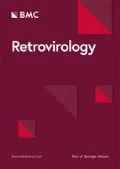Background
While neutralizing antibodies should limit the replication of HIV/SIV in the infected individual, autologous neutralizing antibodies are generated too late following HIV/SIV infection to contribute to early virus control. The present study addresses whether vaccine-induced immune responses accelerate the generation of autologous neutralizing antibodies following SIV challenge in rhesus monkeys, and if this antibody response shapes viral sequence evolution.
Methods
Two groups of six monkeys were vaccinated with a plasmid DNA prime/recombinant adenovirus serotype 5 boost regimen of either gag/pol or env/gag/pol immunogens and subsequently challenged with SIVmac251. Full-length envelope from plasma virus was sequenced by single genome amplification to identify sites of envelope mutations. The rate of the generation of an autologous neutralizing antibody response, and the impact of envelope mutations on escape from antibody neutralization were evaluated using a luciferase reporter gene-based neutralization assay.
Results
The gag/pol vaccinated monkeys developed autologous neutralizing antibody responses by 18 weeks post-challenge, while the env/gag/pol vaccinated monkeys developed this response as early as 7 weeks post-challenge. Moreover, this antibody response in the env/gag/pol-vaccinated group conferred immune pressure on the virus. Phylogenetic analysis of envelope sequences illustrated that env vaccination was associated with an increased accumulation of mutations. Prevalent mutations in sequences from gag/pol vaccinees included deletions in both variable loops 1(V1) and 4, whereas deletions in the env-vaccinees occurred only in V1. A pseudovirion expressing a V1 loop deletion and accompanying point mutations conferred delayed neutralization and escape to sera from env-vaccinees. These findings suggest that env vaccination elicited neutralizing antibodies focused on V1.
Conclusion
Our results indicate that env vaccination is associated with an accelerated development of autologous neutralizing antibodies. These antibodies were focused at least in part on the V1 region of Env, since there was selective pressure in this region of the envelope for the evolution of mutational changes.
Author information
Authors and Affiliations
Rights and permissions
Open Access This article is published under license to BioMed Central Ltd. This is an Open Access article is distributed under the terms of the Creative Commons Attribution 2.0 International License (https://creativecommons.org/licenses/by/2.0), which permits unrestricted use, distribution, and reproduction in any medium, provided the original work is properly cited.
About this article
Cite this article
Basavapathruni, A., Yeh, W., Coffey, R. et al. P04-41. Kinetics of antibody neutralization and viral evolution following envelope vaccination in SIV-infected rhesus monkeys. Retrovirology 6 (Suppl 3), P69 (2009). https://doi.org/10.1186/1742-4690-6-S3-P69
Published:
DOI: https://doi.org/10.1186/1742-4690-6-S3-P69

